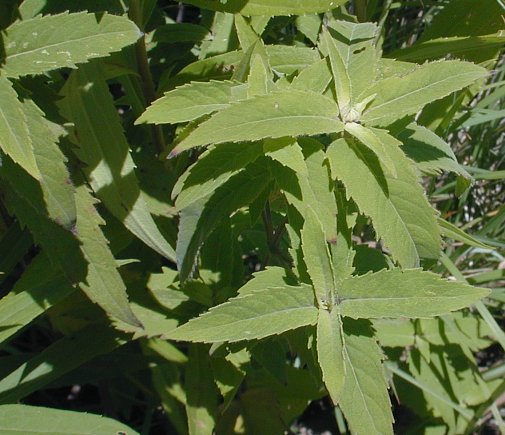Description: This herbaceous perennial plant is 2½–4' tall, branching frequently in the upper half. The light green stems are four-angled and hairless. The opposite leaves are broadly lanceolate to ovate, and vary in color from light green to dark green, sometimes with yellow or red tints. These color variations are in part a response to environmental conditions. The hairless leaves are up to 4" long and 2" across, and have serrated margins. They exude an oregano scent. At the top of major stems are rounded heads of flowers about 1-3" across. The flowers begin blooming in the center of the head, gradually moving toward its periphery, forming a wreath of flowers. Each flower is lavender or pink, and about 1" long, with an irregular shape. The corolla divides into a tubular upper lip with projecting stamens, and three slender lower lips that function as landing pads for visiting insects. The blooming period occurs during mid-summer and lasts about 1 month. The root system consists of deep, strongly branched roots, and shallow rhizomes that are responsible for the vegetative spread of the plant. These rhizomes typically send up multiple leafy stems in a tight cluster, giving Wild Bergamot a bushy appearance.

Cultivation:
The
preference is full or partial sun, and moist to slightly dry
conditions. Growth is more luxuriant in a moist rich loam, although
this can cause the plant to flop around as the growing season
progresses. Under drought conditions, the lower leaves will turn yellow
and drop off the stems; this reaction is normal. The lower leaves often
develop powdery mildew, particularly when the weather is rainy. While
this plant is easy to grow, it often becomes rather dilapidated in
appearance as the growing season progresses because of these problems.
This plant often spreads aggressively.
Range & Habitat:
The native Wild Bergamot occurs throughout Illinois, except for a few
southern
counties within the state (see Distribution
Map). It is occasional to locally common. Habitats include
moist to slightly dry black soil prairies, hill prairies, sandy Black
Oak woodlands, savannas and woodland borders, thickets, borders of
limestone glades, abandoned pastures, and landfills. The rhizomes can
survive earth-moving and bulldozing operations, and send up plants in
unexpected places. Some local populations may be plants that have
escaped cultivation.

Faunal Associations: The nectar of the flowers attracts long-tongued bees, bee flies, butterflies, skippers, and hummingbird moths. Among the long-tongued bees, are such visitors as bumblebees, Miner bees, Epeoline Cuckoo bees, and large Leaf-Cutting bees. A small black bee (Dufourea monardae) specializes in the pollination of Monarda flowers. Sometimes Halictid bees collect pollen, while some wasps steal nectar by perforating the nectar tube. The Ruby-Throated Hummingbird also visits the flowers. The caterpillars of the moths Sphinx eremitus (Hermit Sphinx) and Agriopodes teratophora (Gray Marvel) feed on the foliage. A seed bug (Ortholomus scolopax) is sometimes found in the flowerheads. Mammalian herbivores usually avoid this plant as a food source, probably because of the oregano-mint flavor of the leaves and their capacity to cause indigestion; they may contain chemicals that disrupt populations of beneficial bacteria in the digestive tract.

Photographic
Location:
Photographs were taken at Meadowbrook Park in Urbana, Illinois.
Comments:
For a member of the mint family, the flowers are large and beautiful.
Wild Bergamot can be distinguished from other Monarda spp.
by the color of its flowers – the corollas of its flowers are solid
pink or lavender. Other
species have flowers with red, purple, or white corollas, or they
have dark purple dots on the lower lips of their corollas.